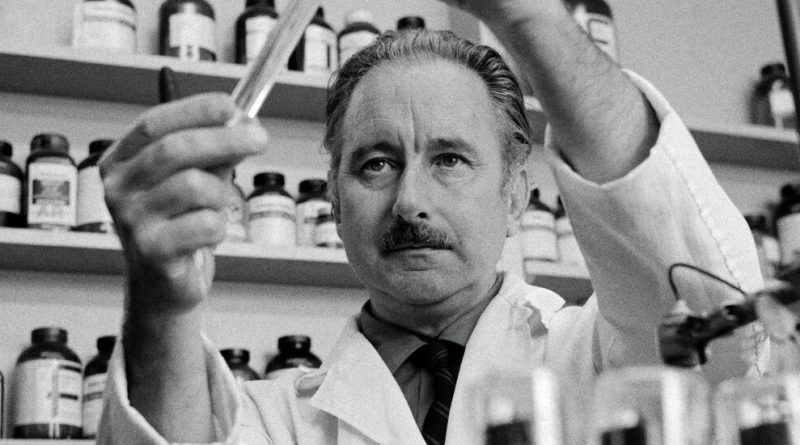Theodor Diener, Who Discovered the Tiniest of Infectious Agents, Dies at 102
Finding something infinitesimally tiny is never easy. But it’s much harder when the searcher doesn’t know what to look for.
Theodor Diener, a plant pathologist at the federal Agricultural Research Service, faced that problem when he began investigating spindle tuber disease, an ailment that makes potatoes scrawny and misshapen.
Dr. Diener, who was 102 when he died on March 28 at his home in Beltsville, Md., worked for years to find the culprit, resulting in the discovery of the smallest known infectious agent, which he named a viroid.
Spindle tuber disease, which was first identified in the 1920s, sometimes causes disastrous consequences for crops. Studies show that the ailment can lower potato crop yields by up to 64 percent; only strict quarantining, and in some cases destruction of entire crops, can contain this highly contagious illness. But even decades after the disease was identified, scientists were still not sure what caused it.
Dr. Diener and colleagues like William B. Raymer at the research service, part of the Department of Agriculture, spent most of the 1960s trying to solve the puzzle.
They studied the pathogen in tomato plants, which they found had a far shorter incubation period for tuber spindle disease than potatoes, and used cutting-edge techniques to figure out that this infectious agent contained no proteins and that RNA, or ribonucleic acid, one of the building blocks of life, was crucial to it.
Dr. Raymer left the research service for a job in private industry in 1966, and Dr. Diener “spent the next five years isolating and characterizing the viroid, verifying his experiments, filling in the holes” and “preparing to meet the skepticism that generally greets proposals of new, ‘impossible’ concepts,” according to a 1989 article in Agricultural Research magazine titled “Tracking the Elusive Viroid.”
At the time, scientists thought that something as small as viroids, which are one eightieth the size of many viruses, were too minuscule to cause an infection.
Like viruses, viroids reproduce by invading healthy cells and reprogramming them to duplicate the viroid’s genetic makeup instead of the cell’s own.
But viruses, which can be made of DNA or RNA, have a protective coat made of proteins and encode proteins once they have invaded cells. Viroids, by contrast, are made only of RNA, do not have the protein coat and do not encode proteins.
“Its method of producing disease is basically different from that of all other viruses,” Dr. Diener said at an international meeting of virologists in 1972.
After identifying the viroid that caused spindle tuber disease, he helped develop a test to detect it. He went on to receive the National Medal of Science from President Ronald Reagan in a Rose Garden ceremony at the White House in 1987.
William Haseltine, a virologist and former professor at Harvard Medical School who has written a series of articles about viroids for Forbes magazine this year, said in a phone interview that Dr. Diener “discovered a whole new branch of life, probably the most fundamental branch of life, at least to my definition.”
Dr. Diener’s discovery has implications for scientific understanding of the origins of life and for medicine, contributing to breakthroughs like the use of messenger RNA to develop vaccines for Covid-19, Dr. Haseltine said.
Since Dr. Diener’s discovery, scientists have identified more than 30 different viroids that cause diseases in plants, like the avocado sunblotch, coconut cadang-cadang, pear blister canker and hop latent viroids, which can be devastating to hemp and cannabis crops.
Theodor Otto Diener was born on Feb. 28, 1921, in Zurich, the only child of Theodor and Hedwig (Baumann) Diener. His father was a postal worker, his mother an accountant.
As a child he was fascinated with animals and kept a colony of mice, a turtle and a canary, much to his parents’ discomfort. His father, he wrote in a self-published memoir, “Of Humans, Humanoids, and Viroids” (2014), did not appreciate his consuming interest in “small living things.”
He “often shook his head in disbelief when I was enthusiastically holding forth — describing attributes of some tiny insect, worm or fungus,” Dr. Diener wrote.
Dr. Diener did airplane maintenance for the Swiss Air Force during World War II, and in 1948 he completed his doctorate in biology at the Swiss Federal Institute of Technology.
He emigrated to the United States in 1949 and, after a brief time in New York City, moved to Spokane, Wash., for a job at the University of Washington. He moved to Maryland to work with the government research service 10 years later.
Dr. Diener’s first marriage, to Shirley Baumann, ended in divorce. In 1968 he married Sybil Fox, who died in 2012.
He is survived by three sons from his first marriage, Michael, who confirmed the death, Theodore and Robert; five grandchildren; and three great-grandchildren.
Dr. Diener’s other honors include his election to the National Academy of Sciences and to the American Academy of Arts and Sciences. In 1987, he received the Wolf Prize in agriculture, a $100,000 award given by the Wolf Foundation in Israel.
Viroids may be much more than agricultural pests. Research suggests that they existed at the earliest stages of life on Earth, unnoticed until Dr. Diener took up the search.
Dr. David A. Relman, a microbiologist at Stanford University, wrote of Dr. Diener in an email, “His discovery of viroids and their role in plant diseases helped to reveal the role of RNA molecules in basic biological processes, and potentially in the origin of life itself.”
Ashley Shannon Wu contributed reporting.
Sahred From Source link Science



